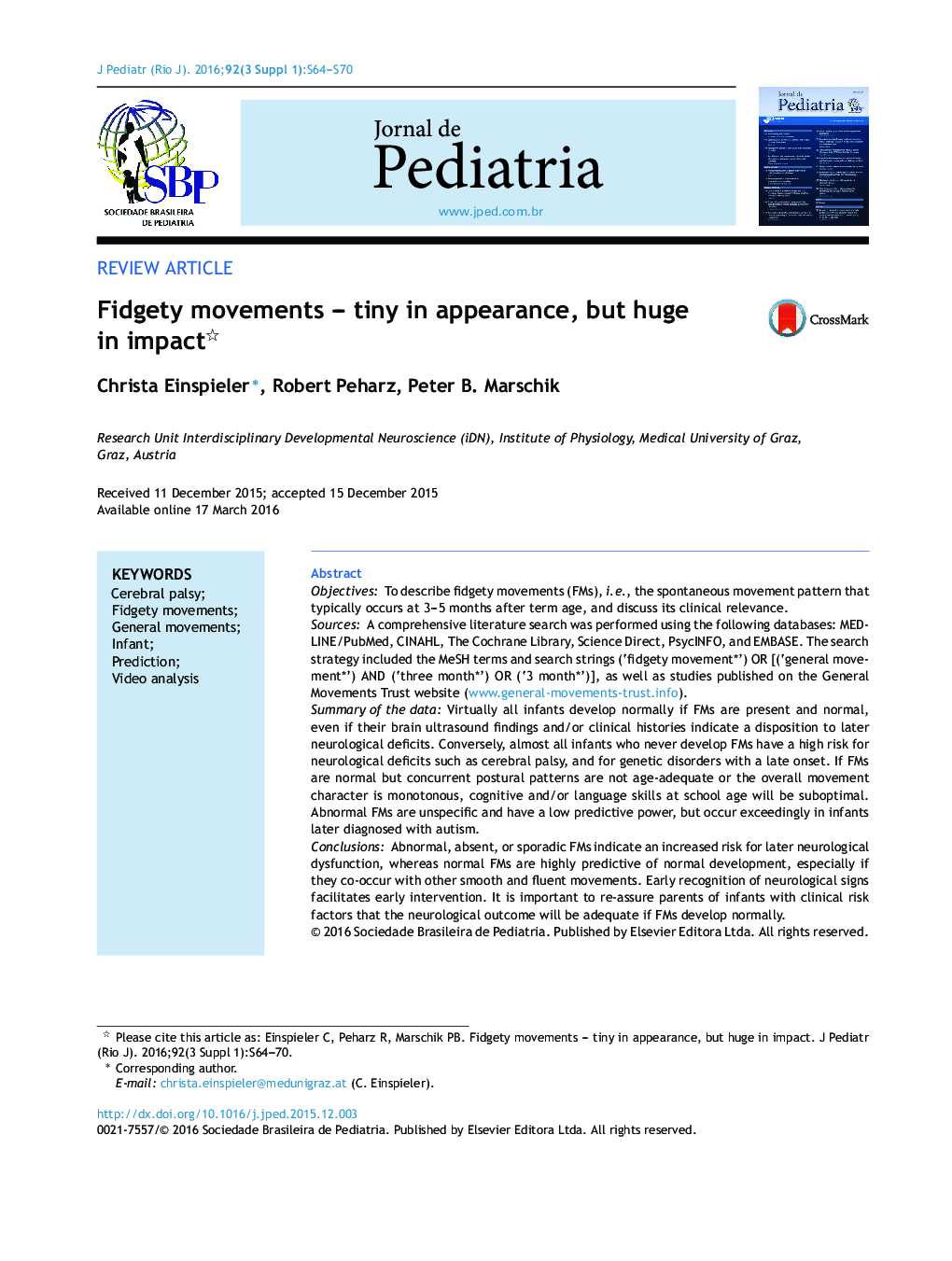| کد مقاله | کد نشریه | سال انتشار | مقاله انگلیسی | نسخه تمام متن |
|---|---|---|---|---|
| 4153795 | 1273675 | 2016 | 7 صفحه PDF | دانلود رایگان |

ObjectivesTo describe fidgety movements (FMs), i.e., the spontaneous movement pattern that typically occurs at 3–5 months after term age, and discuss its clinical relevance.SourcesA comprehensive literature search was performed using the following databases: MEDLINE/PubMed, CINAHL, The Cochrane Library, Science Direct, PsycINFO, and EMBASE. The search strategy included the MeSH terms and search strings (‘fidgety movement*’) OR [(‘general movement*’) AND (‘three month*’) OR (‘3 month*’)], as well as studies published on the General Movements Trust website (www.general-movements-trust.info).Summary of the dataVirtually all infants develop normally if FMs are present and normal, even if their brain ultrasound findings and/or clinical histories indicate a disposition to later neurological deficits. Conversely, almost all infants who never develop FMs have a high risk for neurological deficits such as cerebral palsy, and for genetic disorders with a late onset. If FMs are normal but concurrent postural patterns are not age-adequate or the overall movement character is monotonous, cognitive and/or language skills at school age will be suboptimal. Abnormal FMs are unspecific and have a low predictive power, but occur exceedingly in infants later diagnosed with autism.ConclusionsAbnormal, absent, or sporadic FMs indicate an increased risk for later neurological dysfunction, whereas normal FMs are highly predictive of normal development, especially if they co-occur with other smooth and fluent movements. Early recognition of neurological signs facilitates early intervention. It is important to re-assure parents of infants with clinical risk factors that the neurological outcome will be adequate if FMs develop normally.
ResumoObjetivosDescrever os movimentos irregulares (FMs), ou seja, o padrão de movimentos espontâneos que normalmente ocorrem entre 3 e 5 meses após o nascimento e discutir sua relevância clínica.FontesUma pesquisa abrangente na literatura foi realizada nas seguintes bases de dados: MEDLINE/PubMed, CINAHL, The Cochrane Library, Science Direct, PsycINFO e EMBASE. A estratégia de busca incluiu os termos e cadeias de pesquisa do MeSH [(“fidgety movement*”) OU [(“general movement*”) E (“three month*”) OU (“3 month*”)], bem como estudos publicados no website da General Movements Trust (www.general-movements-trust.info).Resumo dos dadosPraticamente todos os neonatos se desenvolveram normalmente se os FMs estiveram presentes e foram normais, mesmo se seus resultados do ultrassom do cérebro e/ou históricos clínicos indicassem tendência a déficits neurológicos posteriores. Por outro lado, quase todos os neonatos que nunca desenvolveram FMs apresentaram maior risco de déficits neurológicos, como paralisia cerebral, e doenças genéticas de início tardio. Caso os FMs fossem normais, porém simultâneos a padrões posturais não adequados para a idade, ou o caráter geral dos movimentos fosse monótono, as capacidades cognitivas e/ou de linguagem na idade escolar seriam abaixo do ideal. Os FMs anormais não são específicos e têm baixo poder preditivo, porém ocorrem em grande parte em neonatos posteriormente diagnosticados com autismo.ConclusõesFMs anormais, ausentes ou esporádicos indicam um risco maior de disfunções neurológicas posteriores, ao passo que FMs normais são altamente preditivos de desenvolvimento normal, principalmente se forem simultâneos a outros movimentos suaves e fluentes. O reconhecimento precoce de sinais neurológicos facilita a intervenção antecipada. É importante garantir aos pais de neonatos com fatores de risco clínicos que o resultado neurológico será adequado se os FMs se desenvolverem normalmente.
Journal: Jornal de Pediatria - Volume 92, Issue 3, Supplement 1, May–June 2016, Pages S64–S70